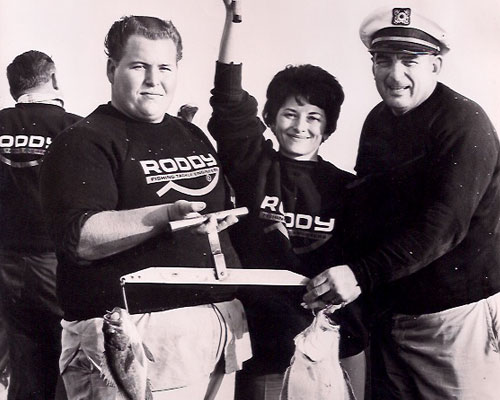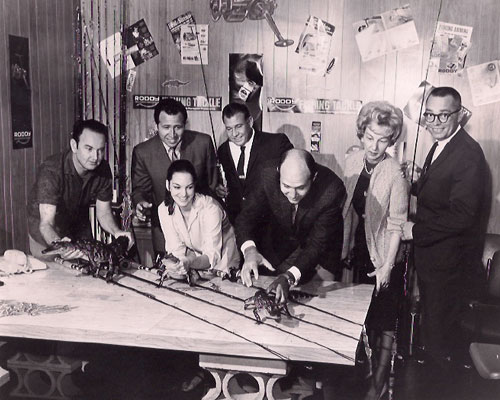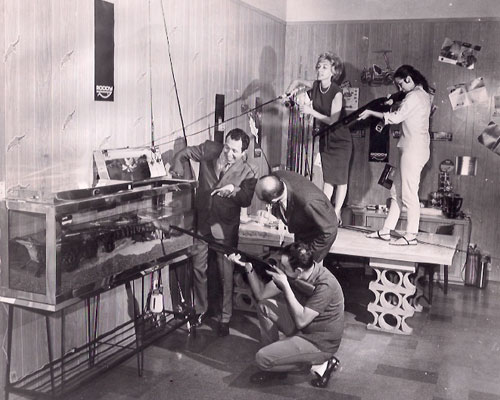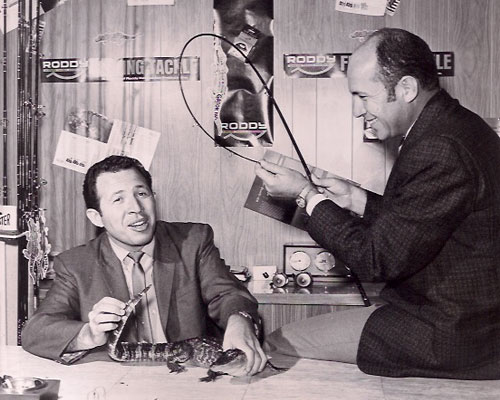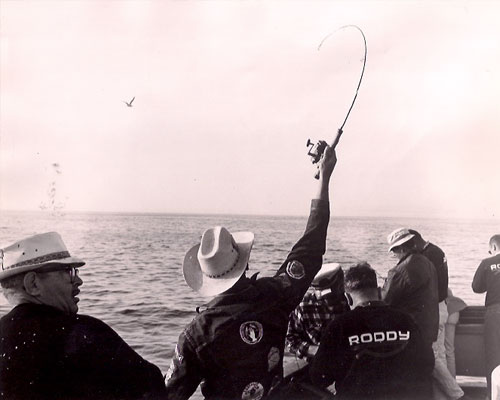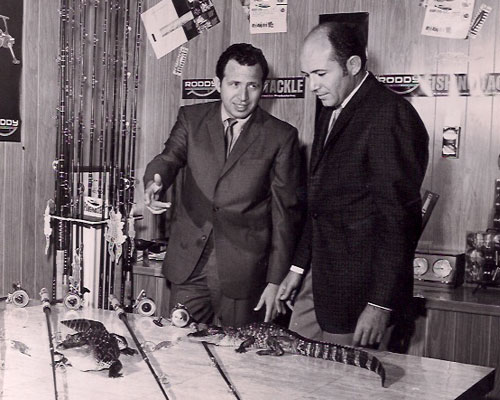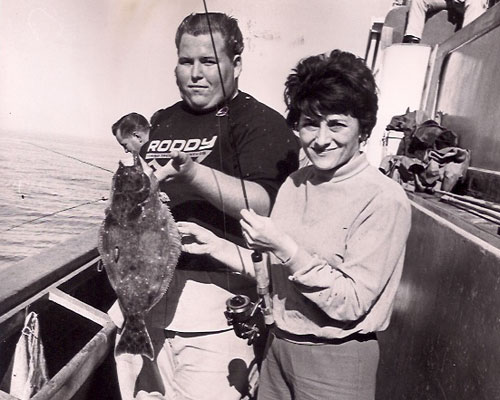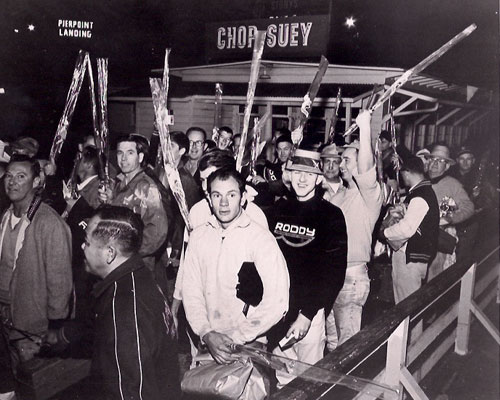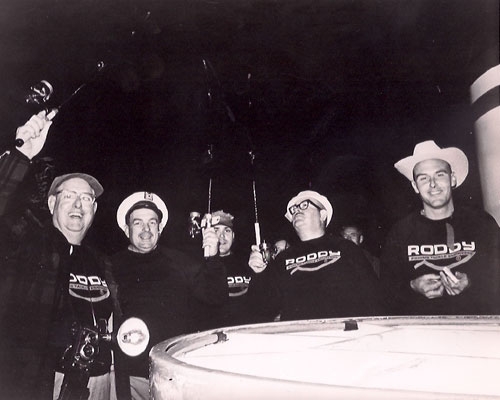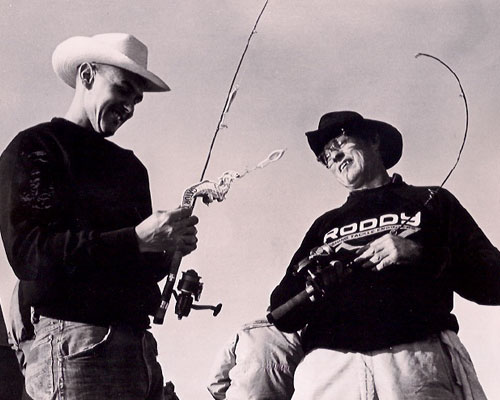About Us
“The birth of big-game fishing occurred in the late 1800s on the West Coast and the early fishing gear used to battle large bluefin tuna, marlin and swordfish evolved here.”… Michael Farrior, International Game Fish Association historian. From the turn of the century, many rod and reel designers combined their skills as expert craftsmen with their experience as anglers to meet the demands of catching the larger fish. These early craftsmen/anglers include Frederick vom Hofe and his sons, Julius and Edward, along with many others. Every aspect of the early tackle from direct-drive knuckle buster reels, cane rods and linen line was ripe for refinement and improvement.
Since then the innovations have been numerous — star drags, spinning reels, fiberglass and composite rods, Dacron, monofilament and braid line are among the many that have become part of the sportfishing vocabulary.
Nearly a half-century later during the mid-50s, wooden rods lost favor as fiberglass gained favor. Oddly, some early fiberglass model designs were finished to appear as wood.
In those formative years, when Harvey “Roddy” Rodstein was about 12 years old and already a zealous angler, he built his first Calcutta rods, one for both his younger brother, Jerry, and himself. Those first two led to more, each with technical and cosmetic refinements that improved both performance and appearance.
...Read MoreBy the time Jerry had returned from a stint in the U. S. Navy, Roddy’s skill had vastly improved and his rods had gained some notoriety, first among friends, then among others eager to purchase one for themselves. What had been a hobby had evolved into a business. He became foreman for Harnell Rods in Venice, eventually leaving there to operate two retail stores in Los Angeles. Soon after, he and Jerry were offered an opportunity to wrap both fresh and saltwater rods for Sears, Roebuck & Company. Howard Ashby and Bob Berry, owners of Conolon Rods, offered to supply the blanks to get them started. They joined forces wrapping rods in their old 15- x 55-foot dilapidated garage building. “We wrapped 300 rods every day – from 7am to 9pm,” Jerry recalled recently, laughing. When other retailers discovered their “Budda Head” fast tip rods, the first inexpensive series known on the West Coast, their business grew rapidly and soon they were selling rods to retailers throughout the United States. Their rapid business growth brought about the need for an expanded management team to face the challenges they were experiencing.
At this point, Bernie Robinson entered the business. Although Robinson had worked for an industrial plastics firm, strangely enough, he wasn’t a fisherman like Roddy and Jerry. They split the responsibilities: Robinson was in charge of the financial aspect of the business; Roddy was in charge of production and design; and Jerry, the ultimate salesman, was responsible for the rapidly growing sales department.
The Rodstein’s recalled that this period of time began with quite a boost, and remembered it as the turbulent 60s.
In order to maintain a reliable flow of unfinished rod blanks and reel components, they pioneered one of the early relationships with Japanese manufacturers which allowed them to meet the explosive demand the company was experiencing. Also Master Fishing Tackle was the was the first to add Roddy irons, adapting a method to die cast them which allowed them the ability to produce a Salas X-style $2- to $3-range lure which could be sold for a dollar.
Always moving forward, they decided to exhibit at the “Los Angeles Sportsmen's Show.”
“1,500 A DAY” screamed the headline, the lead in the local Long Beach Independent, in a story filed by Donnell Culpepper in his Fishin' Around column. “Roddy Rods Grab Lead in 3 Years,” he wrote.
“One of the unique features of the recent Los Angeles Sportsmen's Show was a booth containing nearly 300 different model fishing rods, made by the Roddy Mfg. Co., 1526 W. 166th St., Gardena.
“While most of us have seen Roddy rods in Southland sporting goods stores, there are few, if any, who have ever seen such a collection of rods in one exhibit,” Culpepper continued.
“You wouldn't think that a company could possibly make 275 different rods, each for a certain type of fishing. Most of us couldn't use one-tenth of that number in a lifetime of fishing!
“Yet, the Roddy Co. makes them and sells them — at the rate of 1,500 a day, or 300,000 a year.”
The expanded growth brought even more challenges . . . a higher-than-expected number of their Roddy Rods were returned because of tip breakage. Upon investigation, they discovered a flaw in their process. After the fiberglass was wrapped on a mandrel, the finished rod was wrapped tightly in cellophane to hold everything in place.
Once dried the outer covering was sanded smooth to make the rod cosmetically appealing. However, the sanding was reducing the thickness of the fiberglass layer, which in turn was causing the excessive breakage.
The solution? They wouldn’t sand the thinner upper portion of the rods. However, the spiral tip that was not sanded remained thicker and rough to the touch. On an innovative impulse, Jerry called the modified rods “Gator Tails,” – followed by what would become one of his frequent marketing inspirations.
He purchased 1,800 live baby alligators and had them shipped to their office. Then one by one, the live baby alligators were shipped out individually with each “Gator Tail” order. “I fed them 100 goldfish every day,” he marveled recently. “They grew so fast!”
On another innovative impulse in February, 1962, “Roddy Rods” sponsored a halibut tournament chartering all the southern California sportfishing fleet boats that were available for the one-day affair. Nearly 2,000 entrants registered and were given a 48-inch Roddy rod equipped with a Roddy Gyro spinning reel and a Roddy sweatshirt, plus an opportunity to compete aboard one of the chartered Sportfishers . . . all for $2.50 cash entry fee. The brothers piled all of the cash collected high on Jerry’s desk. Remarkably there were quite a few halibut caught by the huge turnout of anglers in the dead of winter.
Throughout the sixties, the Rodstein’s continued to prosper, opening a new, larger factory employing their 500 employees and Robinson decided to pursue other projects. Leon Todd joined the pair and became the President of Master Fishing Tackle. (Todd was the owner of Cal-Star rods many years later.) Their early BR series was very popular and demand soared; Roddy-type rods were shipped out by the thousands under a variety of different labels to meet consumer demands.
The turbulent sixties faded and the seventies ushered in a remarkable period of productivity for Master Fishing Tackle that continued to ship rods, reels and lures. The Rodstein’s developed a similar strong relationship with Korea just as they had in the early sixties with the Japanese. This continued to provide a reliable source of various manufactured rod and reel components which were shipped to the United States for assembly.
The Rodstein’s Rodac Industrial Air Tools also benefited from the Korea connection for the production of the much needed parts for the air tool manufacturing factory which employed 500 employees.
The BH series rods were added as tackle sales continued to grow; increasing the growing list of Master Fishing Tackle retailers across the United States, Big 5 Sporting Goods contacted Jerry in 1972 and they ultimately became one of their retailers.
In the early eighties, Harry Rodstein started Harden Industries, which became a multi-million dollar company selling high-end brass bathroom fixtures to Beverly Hills residents and beyond. But only a year later, he was diagnosed with cancer and subsequently passed away in 1987 at 57 years old. His wife, Barbara Nyden- Rodstein assumed management of Harden Industries.
It was after the sale, that Jerry, in his 40s, considered retirement. However, it wasn’t long before he discovered that all of his peers that were still working and weren’t available to even take a long lunch with him. So he plunged right back into the business opportunities that seemed to invariably come his way.
Jerry, with Master Fishing Tackle and other various subsidiaries operating well, turned his attention back to sportfishing, which was the driving force that had inspired his business activities from the beginning.
He and his partner, Tim Bailey purchased a 42-foot Seaward hull that was purchased from Tom Schlauch and completed by Bob Aguilar. They chose the name “Los Compañeros” which remained the chosen name for all future sportfishers they owned, subsequently selling it before buying a 54-foot Bertram. Keeping his boat in Cabo San Lucas, he flew down monthly to fish both offshore and inshore with clients and friends. He enjoyed this time so much that he upgraded to larger boats, ultimately ending up with a 2002 61-foot Viking that has recently returned to California.
On December 31, 2002, Jerry Rodstein, owner of Master Fishing Tackle, and Dick Henry, owner of Sea Striker, jointly purchased PENN Fishing Tackle; Dick Henry was also the founder of wholesale tackle distributor, Henry's, and each owned several other companies as well.
Rodstein and Henry operated PENN Fishing Tackle separately from their other companies as Penn had its own management team, several of whom are prominent in the tackle industry today, still involved with other companies.
Subsequently, Rodstein and Henry sold Penn to K2, which owned K2 Skis, Rawlings Baseball, Shakespeare Fishing, and other sports companies.
A few months later, K2 was sold to current owners, Jarden Corp., and Penn and Shakespeare became part of Pure Fishing, which includes Abu-Garcia, Berkley, Fenwick, etc. The "non-fishing" sports companies became part of Jarden Outdoor Solutions and includes Coleman Camping, etc.
Another winner was the Roddy Spin Lite®. Seems that Jerry hooked up with the inventor who was promoting his new spinning reel at the Fred Hall, Long Beach Show, in 2008; the reel lit up as the handle was turned. Recognizing an opportunity, Jerry managed to purchase the sales rights to the reel and subsequently the patent for the device — which to this day is still a popular item in the Master Tackle Company catalog.
Master Tackle Company continues to operate from its location in Carson, California where Jerry Rodstein is still at his desk each morning at 9 a.m. surrounded by shelves and tables laden with past and future tackle successes. That’s where I found him, eager to reminisce about his remarkable fishing tackle industry achievements during his more than six-decade career that careened from opportunity to opportunity. We discussed their breakthroughs like the thick-walled, fast taper BR series; the fact that Collectors clamor to purchase some of Roddy’s early model BR and BH series at 10, 20, or 30-times their original price; and the shipping of millions of rods to retailers over the past 60 years which placed Master Tackle Company and its subsidiaries in strong competition for the most rods sold with Conolon, Calstar, Harnell, Sabre, Truline, Lamiglas and Abu Garcia. As I was leaving, Pat Schlauch, recently named Vice President of Sales introduced himself. “I’m thrilled to be allowed to follow in Jerry’s footsteps,” he proudly acknowledged, “and in his rich heritage of creative innovation and entrepreneurship in running Master Tackle Company and Roddy Rods.”

